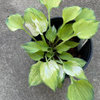Crown Rot is the result of a diseased or stressed plant under attack by a host of organisms leading to the mushie condition we call crown rot.
Southern Blight or Sclerotium Rolfsii is a group of related soil borne organisms which are a bit more specific leading to something similar to crown rot. Southern Blight ususally appears in summer when temperatures reach high 80's or above. It also seems to appear after rains and high temperatures. Treatment is 10% household bleach or 1% by volume as a drench of the plant and soil. Since it is soil borne it will move down a slope and reappear next year in the general area so treating the whole area is proper.









Hosta_Haven
donrawson
Related Professionals
Brentwood Landscape Architects & Landscape Designers · Mooresville Landscape Contractors · Maple Valley Landscape Contractors · Cary Landscape Contractors · Forest Hills Landscape Contractors · Golden Gate Landscape Contractors · Teaneck Landscape Contractors · Yuba City Landscape Contractors · Escondido Driveway Installation & Maintenance · American Fork Fence Contractors · Coral Gables Fence Contractors · Los Angeles Fence Contractors · Maynard Fence Contractors · Carson Solar Energy Systems · Payson Solar Energy Systemsesther_opalOriginal Author
Jennifer Schwarz